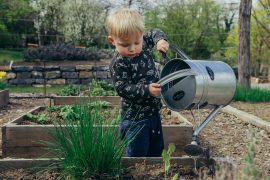I like simple tubular bandages, because they slip on and off easily and don’t need any pins or fastenings.
If you can afford to have a few belly wraps it’s useful to have one to wear, one for the wash and one for your baby brain to lose track of!
Also buy yourself some organic black sesame oil, because the sanskrit word for oil (sneha) means love, and that’s what it’s all about.
How Do I Wrap My Belly?
Rub a generous amount of warm sesame oil over your abdomen (ideally as part of your daily oil massage). If you only have one belly wrap you may like to add an extra layer of cotton first to protect your wrap. If you have a spare wrap you can use your wrap straight on top of the oil and wash it every few days.
Your wrapping should feel like a gentle, comfortable, compression, and should not restrict your breathing or movement in any way. It’s really just common sense. After a few days, you’ll figure out what feels good for you. A heat pack on your abdomen can feel oh-so-nourishing too.
To wash the oil out of your belly wrap throw it in your washing machine on a hot cycle with a small amount of dishwashing machine powder (yes dishwashing). Dry your wrap on the line, as oily linen can cause a fire in the dryer.
How Long Should I Wrap My Belly?
Again this is entirely dictated by your comfort levels. I haven’t found any guidelines in the ancient Ayurvedic texts. Some women like to leave their wrap on for 24 hours a day for weeks. Others prefer to take it off at night. Four hours a day after your massage may be enough for you. My teacher, Ysha Oakes, talks about a 90-year-old great-grandmother who was still wearing her belly wrapping since her own babies were born.
That’s it. Keep it simple, and be guided by your comfort. Enjoy! Have you wrapped your belly? Did it feel good?
For more information on nourishing postpartum traditions check out my recipe book, Nourishing Newborn Mothers.
Original article published HERE
Julia Jones is a postnatal doula leading a worldwide renaissance in the way we care for Newborn Mothers. She has created a new paradigm for postpartum care by merging traditional medicine and culture with cutting-edge research on hormones and neurology.
Julia is the author of both ‘Nourishing Newborn Mothers – Ayurvedic Recipes to Heal your Mind, Body and Soul after Childbirth’ and ‘Newborn Mothers – When a Baby is Born So is a Mother’ (www.newbornmothers.com/books/). Julia is also the creator of the worldwide leading education resource for postpartum professionals: Newborn Mothers Collective (www.newbornmothers.com/training).










